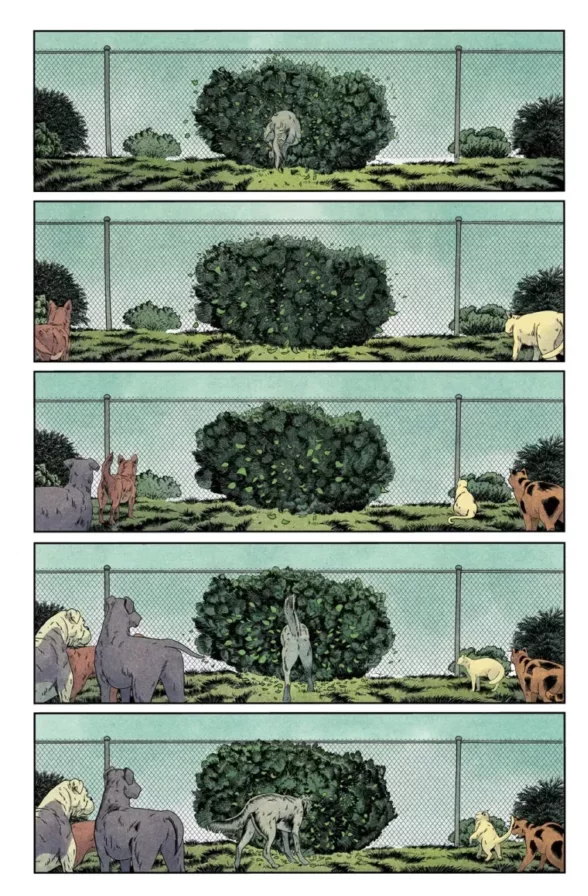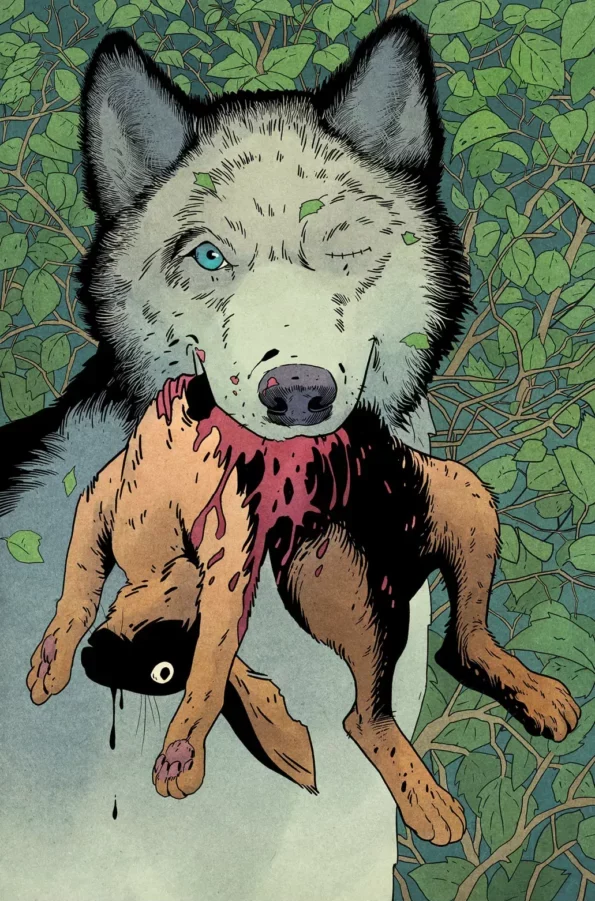There are dark clouds gathering on the horizon of BOOM! Studios’ Animal Pound. The first pages show us a rabbit running from a hungry dog. In the face of starvation, the order the animals have fought so hard for begins to crumble. Writer Tom King, artist Peter Gross, colorist Tamra Bonvillain, and letterer Clayton Cowles present pages drenched with both hope and dread in this week’s Animal Pound #2.
Writing
As previously discussed, Animal Pound is an homage to George Orwell’s classic novel Animal Farm. King shows us in this issue that he’s making big changes to the source material to tell his own version of the story. For one thing, the hierarchy of the animals is more immediately obvious than it is in Orwell’s tale. The dogs are the largest animals in the pound, the cats the most cunning, and the rabbits the most vulnerable. The dwindling of food supplies begins earlier in the plot than it did for Orwell’s livestock friends. Yet there’s plenty more to make Animal Pound nuanced in ways that its spiritual parent was not.
The unofficial leaders of the pound are Fifi the cat and Titan the dog. With this, King adds a layer of tension. Orwell’s story featured two pigs who were at odds with one another. They may have differed ideologically, but they were still the same kind of animal. With this change, King questions what it means to have power. The dogs can physically overpower any of the others, yet the cats seem like they could outsmart any of the animals. And as the animals realize that they need to find a solution to their diminishing resources, King introduces one final, brilliant element to the story that plants us firmly in the modern era. You’ll have to read it to see exactly what I mean. In Animal Pound #2, King pairs a poetic, metered, and eloquent writing style – which echoes Orwell’s own voice so gracefully – with contemporary themes to show us that we are still wrestling with the same obstacles Animal Farm warned us about so many years ago. Animal Pound suggests that the enemies are the same; it’s only their weapons that have changed.

Art
Gross’ art is incredible in its ability to convey details through such subtlety. Despite the fact that Gross’ subjects are all animals, and it ought to be complicated to show their expressions, he has no trouble clueing us in on what they’re feeling. In one of the first pages, when a dog chases a rabbit into a bush, Gross draws several cats and dogs who are slowly making their way over, curious about what’s going on. Through their understated body language, he begins to build the panic that must be spreading through the pound, as in each passing panel they realize their dreams of an ordered society might be slipping away.

Gross also brilliantly depicts time passing in one particular scene. As nine animals gather to discuss things, he uses the De Luca effect – drawing the same characters over and over again in the same two page splash – to show us how long their deliberations must be. Government, Gross points out, takes a tremendous amount of patience and willpower.
Coloring
Bonvillain’s use of colors is unbelievably brilliant. The scene of the dog chasing the rabbit, which ought to seem terrifying and ominous, Bonvillain colors brightly. When the dog holds the rabbit’s dead body in his mouth, the straightforward palette almost seems to ask the question “Isn’t this totally normal for dogs to do?” As the story progresses, we get plenty more scenes where Bonvillain seems to underscore the imminent doom in the text. Dark blues, deep purples, and intense greys surround the hushed conversations of characters who are trying their best to stop everything from falling apart. And yet, after Bonvillain sets us up with that very first scene being so innocently colored, there’s almost a sense of more dread every time the panels return to a brighter tone.
Bonvillain is asking us to look at the storm that’s brewing beneath the surface. When things look normal, are they? Or are the characters just getting better at convincing themselves they’ve fixed the problem?

Lettering
There are so many wonderful things that Cowles does with the lettering in this issue. For one thing, every growl, bark, and cry has a specifically designed sound effect for it. Each follows its own bumpy trail across the page, sometimes with the letters tilted in italics or stretched in an apparent panicked scream. You can hear the timber and rhythm of every sound. One of the best moments of Animal Pound #2, however, is when a rabbit is given the floor to speak to a group of other animals. The rabbit breathlessly and endlessly goes on about some problem that they have. Cowles letters the character’s word balloons so that its edges actually cut off the words they’re saying. It’s just a mass of unorganized text, blathered out as word vomit by an overeager bunny. It’s a great choice that lends itself to the story, while also giving you a moment to chuckle.
Verdict
Animal Pound #2 is another home run for this creative team. It differentiates itself even more from its spiritual predecessor, while keeping the soul of Animal Farm intact. This is not a simple rehashing of George Orwell’s tale. This is a comic for us, for now. In many ways, it feels like Orwell is still with us — he’s just changed his medium so as to appeal to the true intellectuals of our generation. Check out Animal Pound #2, out from BOOM! Studios this week at a comic shop near you!

